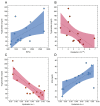Sensing Biomechanical Alterations in Red Blood Cells of Type 1 Diabetes Patients: Potential Markers for Microvascular Complications
- PMID: 39727851
- PMCID: PMC11674557
- DOI: 10.3390/bios14120587
Sensing Biomechanical Alterations in Red Blood Cells of Type 1 Diabetes Patients: Potential Markers for Microvascular Complications
Abstract
In physiological conditions, red blood cells (RBCs) demonstrate remarkable deformability, allowing them to undergo considerable deformation when passing through the microcirculation. However, this deformability is compromised in Type 1 diabetes mellitus (T1DM) and related pathological conditions. This study aims to investigate the biomechanical properties of RBCs in T1DM patients, focusing on identifying significant mechanical alterations associated with microvascular complications (MCs). We conducted a case-control study involving 38 T1DM subjects recruited from the Diabetes Care Unit at Fondazione Policlinico Gemelli Hospital, comprising 22 without MCs (control group) and 16 with MCs (pathological group). Atomic Force Microscopy was employed to assess RBC biomechanical properties in a liquid environment. We observed significant RBC stiffening in individuals with MCs, particularly during large indentations that mimic microcirculatory deformations. Univariate analysis unveiled significant differences in RBC stiffness (median difference 0.0006 N/m, p = 0.012) and RBC counts (median difference -0.39 × 1012/L, p = 0.009) between the MC and control groups. Bivariate logistic regression further demonstrated that combining these parameters could effectively discriminate between MC and non-MC conditions, achieving an AUC of 0.82 (95% CI: 0.67-0.97). These findings reveal the potential of RBC biomechanical properties as diagnostic and monitoring tools in diabetes research. Exploring RBC mechanical alterations may lead to the development of novel biomarkers, which, in combination with clinical markers, could facilitate the early diagnosis of diabetes-related complications.
Keywords: Atomic Force Microscopy; biomarkers; biomechanics; blood biochemistry; diabetes; microvascular complications; red blood cells.
Conflict of interest statement
The authors declare no conflicts of interest.
Figures








Similar articles
-
Investigation of red blood cell mechanical properties using AFM indentation and coarse-grained particle method.Biomed Eng Online. 2017 Dec 19;16(1):140. doi: 10.1186/s12938-017-0429-5. Biomed Eng Online. 2017. PMID: 29258590 Free PMC article.
-
The relationship between red blood cell deformability metrics and perfusion of an artificial microvascular network.Clin Hemorheol Microcirc. 2014;57(3):275-89. doi: 10.3233/CH-131719. Clin Hemorheol Microcirc. 2014. PMID: 23603326 Free PMC article.
-
Erythrocyte viscoelastic recovery after liver transplantation in a cirrhotic patient affected by spur cell anaemia.J Microsc. 2020 Dec;280(3):287-296. doi: 10.1111/jmi.12958. Epub 2020 Sep 17. J Microsc. 2020. PMID: 32885445
-
Synergistic Integration of Laboratory and Numerical Approaches in Studies of the Biomechanics of Diseased Red Blood Cells.Biosensors (Basel). 2018 Aug 10;8(3):76. doi: 10.3390/bios8030076. Biosensors (Basel). 2018. PMID: 30103419 Free PMC article. Review.
-
Nitric oxide bioavailability for red blood cell deformability in the microcirculation: A review of recent progress.Nitric Oxide. 2022 Dec 1;129:25-29. doi: 10.1016/j.niox.2022.09.004. Epub 2022 Sep 30. Nitric Oxide. 2022. PMID: 36184009 Review.
References
-
- Sun H., Saeedi P., Karuranga S., Pinkepank M., Ogurtsova K., Duncan B.B., Stein C., Basit A., Chan J.C.N., Mbanya J.C., et al. IDF Diabetes Atlas: Global, regional and country-level diabetes prevalence estimates for 2021 and projections for 2045. Diabetes Res. Clin. Pract. 2022;183:109119. doi: 10.1016/j.diabres.2021.109119. - DOI - PMC - PubMed
-
- Solini A., Penno G., Bonora E., Fondelli C., Orsi E., Arosio M., Trevisan R., Vedovato M., Cignarelli M., Andreozzi F. Diverging association of reduced glomerular filtration rate and albuminuria with coronary and noncoronary events in patients with type 2 diabetes: The renal insufficiency and cardiovascular events (RIACE) Italian multicenter study. Diabetes Care. 2012;35:143–149. doi: 10.2337/dc11-1380. - DOI - PMC - PubMed
-
- Voigt M., Schmidt S., Lehmann T., Köhler B., Kloos C., Voigt U.A., Meller D., Wolf G., Müller U.A., Müller N. Prevalence and progression rate of diabetic retinopathy in type 2 diabetes patients in correlation with the duration of diabetes. Exp. Clin. Endocrinol. Diabetes. 2018;126:570–576. - PubMed
MeSH terms
Substances
LinkOut - more resources
Full Text Sources
Medical

